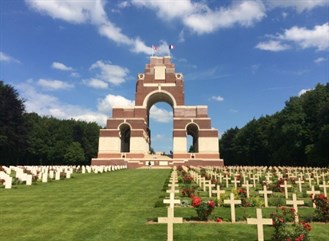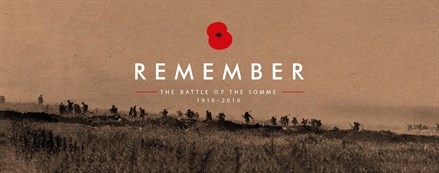Intended to be a decisive breakthrough, the Battle of the Somme instead became a byword for futile and indiscriminate slaughter, with General Haig's tactics remaining controversial even today.
The British planned to attack on a 24km (15 mile) front between Serre, north of the Ancre, and Curlu, north of the Somme. Five French divisions would attack an 13km (eight mile) front south of the Somme, between Curlu and Peronne. To ensure a rapid advance, Allied artillery pounded German lines for a week before the attack, firing 1.6 million shells. British commanders were so confident they ordered their troops to walk slowly towards the German lines. Once they had been seized, cavalry units would pour through to pursue the fleeing Germans.
However, unconcealed preparations for the assault and the week-long bombardment gave the Germans clear warning. Happy to remain on French soil, German trenches were heavily fortified and, furthermore, many of the British shells failed to explode. When the bombardment began, the Germans simply moved underground and waited. Around 7.30am on 1 July, whistles blew to signal the start of the attack. With the shelling over, the Germans left their bunkers and set up their positions.
As the 11 British divisions walked towards the German lines, the machine guns started and the slaughter began. Although a few units managed to reach German trenches, they could not exploit their gains and were driven back. By the end of the day, the British had suffered 60,000 casualties, of whom 20,000 were dead: their largest single loss. Sixty per cent of all officers involved on the first day were killed.
It was a baptism of fire for Britain's new volunteer armies. Many 'Pals' Battalions, comprising men from the same town, had enlisted together to serve together. They suffered catastrophic losses: whole units died together and for weeks after the initial assault, local newspapers would be filled with lists of dead, wounded and missing.
The French advance was considerably more successful. They had more guns and faced weaker defences, yet were unable to exploit their gains without British backup and had to fall back to earlier positions.
With the 'decisive breakthrough' now a decisive failure, Haig accepted that advances would be more limited and concentrated on the southern sector. The British took the German positions there on 14 July, but once more could not follow through. The next two months saw bloody stalemate, with the Allies gaining little ground. On 15 September Haig renewed the offensive, using tanks for the first time. However, lightly armed, small in number and often subject to mechanical failure, they made little impact.
Torrential rains in October turned the battlegrounds into a muddy quagmire and in mid-November the battle ended, with the Allies having advanced only 8km (five miles). The British suffered around 420,000 casualties, the French 195,000 and the Germans around 650,000. Only in the sense of relieving the French at Verdun can the British have claimed any measure of success.

Its 100th anniversary provides an opportunity to commemorate the Service and sacrifice of those who lost their lives in the battle, to reflect upon the human cost of conflict and to have hope for a more peaceful world.
In Stotfold we have managed to find and trace the following armed personnel who unfortunatly, didn't see home again.
I am very hopefull to find those of Arlesey and equally surrounding areas to add to this list and each and every person, male or female, young or old, will be acknowledged and remembered as equals for there sacrifice.
ALLEN Harold - private 34908 7th Batallion Royal Fusiliers.
BASS Alfred - gunner 83285 Royal Garrison Artillery.
BROWN Wilfred Henry - private 37088 1st Batallion Bedfordshire regiment.
GENTLE Ernest Jonathon - private 27725 2nd Batallion Bedfordshire regiment.
KITCHENER Charles Clifford - Lance Corporal 14241 2nd Batallion Bedfordshire regiment.
REYNOLDS William - private 20859 6th Batallion Bedfordshire Regiment.
Some of our members will be attending the Memorials and Commemorations with blessed (By the Revd. Bill Britt who does so much in support I cannot thank enough), wreaths and individually named and carved Poppy Crosses.
The links below should gain you access to all the celebrations and ideas, contributions and efforts made by, to chose my wording carefully yet quote Sir Winston Churchill "the brave and the few".
On a personal note, celebration is the wrong word to use as frequently used in media headlines. It is niether a commiseration nor celebration, it is acknowldgement of all our fallen comrades and a reminder that a war or battle such as the world entered into 100 years ago and we remember to this day, should never happen again.
Soaring above the former battlefields of northern France, the Thiepval Memorial to the Missing of the Somme is one the most distinctive monuments in the CWGC's care.
More than 72,000 British and South African soldiers who have no known grave are remembered on its multiple arches, the majority troops who fell in the Allied offensive of July-November 1916.
http://somme2016.org/
http://www.somme-battlefields.com/centenary-somme-centenary-14-18/commemorations-2016-countdown-has-begun
Stotfold
Thursday 30th June 2016 - Somme Candlelit Vigil at sundown
(9-24pm) at Stotfold Cemetery War Memorial, convening at 9-00pm.
Friday 1st July 2016-Battle of the Somme Service of Remembrance at
St Mary's Church, Stotfold at 6-30pm - County & Branches
welcomed with Standards.
Sundays 3rd & 10th July 2016-Stotfold Mill Somme Exhibition-Free
Entry 12-30 - 5-00pm both days.We are planning a significant
display.
Arlesey
Thursday 30th June 2016-Somme Candlelit Vigil at sundown at the
Arlesey War Memorial (junction of Church Lane/ House Lane/High
Street). Convene at 9-15pm. Rev'd G Boult to officiate.
Sunday 3rd July 2016-Battle of Somme to be remembered at the Morning
Service at 9-30am.
